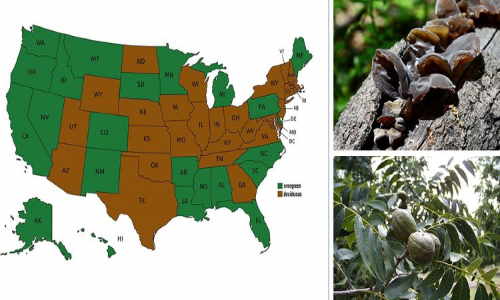
This article was originally published by Rachael Blasbalg on www.askaprepper.com
Nowadays, when we think about the food we eat, we think of food that someone has grown and harvested. Even when we plan for SHTF, we are preparing what we will plant in our gardens.
But in the past, before supermarkets and large agriculture, many people supplemented their diets with food that grew wild, provided by Mother Nature.
The forest around us supplies us with many edible plants and trees that we can forage and eat. And knowing the edible trees and plants in your area can make the difference between survival and starvation when SHTF.
So let’s talk about some common edible trees that grow in your state so that you can be prepared for any eventuality.
#1. Alabama
- PawPaw, Pecan, Hickory Nuts
#2. Alaska
#3. Arizona
- Maple, Birch, Pine, Sycamore, Oak
#4. Arkansas
- Acorns/Oak, Walnut Family, Juniper, Sumac
#5. California
- Holly leaf cherry, Olives, California Hazelnut, Acorns/Oak, Pinyon Pine
#6. Colorado
- Cherry/Choke Cherry Pin Cherry Pine
#7. Connecticut
- Maple, Black Cherry, Birch, Beech, Pine
#8. Delaware
- Black Cherry, Maple, Slippery Elm, Pine
#9. Florida
- Mulberry, Persimmon, Oak, Maple, Pine
#10. Georgia
- Oak, Pine, Hickory, Maple
#11. Hawaii
- Breadfruit, Papaya, Coconut Palm, Mango, Noni, Guava
#12. Idaho
- Pines-including Pinyon Pine, Tamarack, Maple, Birch
#13. Illinois
- Black Walnut, Oak, Hickory, Pecan, American Chesnut, Linden, Hawthorn
#14. Indiana
- Pawpaw, Black Walnut, Mulberry, Beech, Hickory, Maple
#15. Iowa
- Serviceberry, Walnut, Cherry, Oak, Maple, Pine, Hickory, Mulberry, Birch
#16. Kansas
- Mulberry, Pecan, Black Walnut, Hickory, Oak
#17. Kentucky
- Serviceberry, Pawpaw, Persimmon, Pecan, Hickory, Walnut, Oak, Beech
#18. Louisiana
- Palm, Birch, Beech, Oak, Mulberry, Pine, Hickory, Walnut
#19. Maine
- Pine, Beech, Birch, Maple, Oak, Plum, Cherry, Chesnut, Butternut, Hickory
#20. Maryland
- Pine, Oak, Maple, Hickory, Beech
#21. Massachusetts
- Pine, Maple, Oak, Birch, Hickory, Walnut, Beech, Chesnut, Mulberry
#22. Michigan
- Maple, Beech, Birch, Pine, Oak, Hickory
#23. Minnesota
- Pine, Tamarac, Birch, Walnut, Butternut, Beech, Cherry, Hickory, Maple, Oak
#24. Mississippi
- Beech, Birch, Cherry, Pine, Persimmon, Oak, Maple, Walnut. Hickory, Pecan
#25. Missouri
- Eastern Redbud, Birch, Wild Apples, Beech, Oak, Pine, Maple, Walnut, Hickory
#26. Montana
- Pine, Maple, Birch, American Plum, Chokecherry, Oak
#27. Nebraska
- Pawpaw, Persimmon, Hazlenut, Walnut
#28. Nevada
- Pine, Maple, Birch, Serviceberry, Western Chokecherry
#29. New Hampshire
- Pine/Spruce, Beech, Birch, Cherry, Chesnut, Hickory, Maple, Oak, Serviceberry, Walnut
#30. New Jersey
- Oak, Pine, Walnut, Hickory, Chesnut
#31. New Mexico
- Chokecherry, Pine, Oak, Maple
#32. New York
- Serviceberry, Wild Cherry, Wild Apple, Hickory, Butternut, Walnut, Chesnut, Oak, Hazelnut, Pine, Maple
#33. North Carolina
- Pine, Maple, Oak, Hickory, Birch
#34. North Dakota
- Pine/Spruce, Cherry Oak, Maple, Walnut
#35. Ohio
#36. Oklahoma
- Black Walnut, Black Cherry, Hickory, Oak, Pine
#37. Oregon
- Maple, Oak, Pine, Hazelnut
#38. Pennsylvania
- Pawpaw, Hickory, Chesnut, Common Persimmon, Butternut, Red Mulberry, Plum, Cherry, Hazelnut
#39. Rhode Island
- Maple, Oak, Birch, Pine, Black Cherry
#40. South Carolina
- Pine, Oak, Maple, Cabbage Palmetto, Sycamore
#41. South Dakota
- Black Walnut, Oak, Chokecherry, Spruce, Pine
#42. Tennessee
- Oak, Pecan, Beech, Black Walnut, Pine, Black Cherry, Maple, Sycamore, Hickory
#43. Texas
#44. Utah
- Pine, Birch, Linden, Beech
#45. Vermont
- Maple, Pine, Spruce, Oak, Birch, Chokecherry, Linden
#46. Virginia
- Plum, Persimmon, Mulberry, Pawpaw, Wild Plum, Black Cherry, Pine, Spruce, Black Walnut, Hickory, Birch, Chesnut, Beech, Oak, Sycamore, Maple
#47. Washington
- Pine, Spruce, Birch, Maple
#48. West Virginia
- Oak, Sycamore, Serviceberry, Oak, Maple, Birch, Black Cherry
#49. Wisconsin
- Maple, Beech, Black Walnut, Slippery Elm, Birch, Butternut, Black Cherry, Oak, Tamarack, Hickory
#50. Wyoming
- Pine, Spruce, Maple, Birch, Chokecherry, Oak, Linden
Acorns/Oak Trees
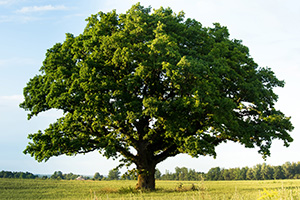
Oaks are common across much of the US, which is great because they are a useful edible tree. However, while you will find oaks growing in most US states, they do not grow in the central west.
You may have heard before that you can eat acorns, and it’s true.
People have been eating acorns since ancient times. While all acorns are edible (if processed correctly), some taste better than others. For example, the acorns from white oaks taste better than those from red oak.
White oaks can be distinguished from other oaks by the rounded tips on their leaves. White oak acorns taste better because they are lower in tannins. Tannins are what are responsible for the bitter flavor. If you are eating red oak acorns, you will want to leech the tannins out before eating them.
You can do this by soaking the shelled acorns for a few days or boiling them. You can also roast acorns to improve their flavor.
Once you’ve prepped your acorns, you can snack on them like nuts or grind them up into flour. You can use your flour to make porridge or dough that can be cooked into cakes.
Acorns aren’t the only edible part of the oak. You can also make wine from oak leaves.

Beech
Another tree with an edible nut is the beech tree.
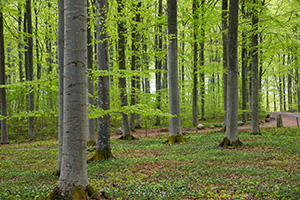
Found all along the East coast of the US, once very popular beech nuts have declined in popularity since the rise of the industrialization of food.
The spiky shells and small size make beech nuts harder to process than many others, and now they are almost forgotten.
While beechnuts can be eaten raw in small quantities, the outer skin contains fagin, which is mildly toxic. However, you can gently cook the seeds and then easily remove the skin on the kernel.
Like the oak, you can eat more than just the nuts off the beech tree. In spring the young leaves can be picked and eaten, providing much needed greens after a long winter.
You can also eat the inner bark of the beech tree. Don’t harvest the inner bark of a living tree unless it is a true survival situation. Otherwise, look for a tree that has recently fallen and forage from that.
Birch
You can find birch trees of one species or another pretty much everywhere in the US.
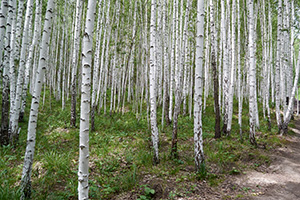
They are distinctive because of their white, papery outer bark, making them an easily identifiable edible tree. Unlike beech and oak, birch trees don’t have any edible nuts. But don’t let that deter you. You will find that plenty of the birch tree is edible. Leaves, twigs, bark, and even sap can be added to your diet.
Leaves should be eaten young and can be steamed or sauteed. You can harvest the inner bark in the same manner as beech bark. Remove the outer layer to get to the soft inside part.
This bark can be cut into strips and boiled like “spaghetti,” can be dried, ground, and used like flour, or can even be eaten raw if you are really desperate. You can even use the twigs, leaves, and buds to make a tea with a slight wintergreen taste.
Related: How To Make Fuel From Birch
Last but not least, you can tap the sap of the birch tree for a sweet drink that you can boil down into a syrup.
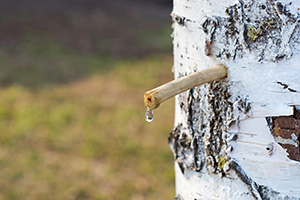
Birch sap is much more watered down than maple sap so you need to harvest a lot of birch sap to get any kind of quantity of birch syrup.
Traditionally this syrup was used to make birch beer- a low alcohol fermented beverage similar to root beer or sasparilla.
Maple
Maple is another tree that is fairly well distributed across the US. We may associate maple trees with Vermont or Canada, but you can find a native maple species in every US state except Hawaii. In Hawaii, Japanese dwarf maples can grow with care, but I wouldn’t call them common.
While we all know we can get maple syrup by cooking down the sap from maple trees but did you know other parts of the tree are edible too?
Leaves, seeds, and bark are also edible.
Pick your maple leaves in spring when they are young. You can eat them raw or cooked. They have a slight familiar maple sweetness to them. If you are really feeling creative you can fry them in tempura batter like they do in Japan.
You find the seeds in the spinny maple “helicopters” that I used to stick on my nose as a kid. In each one is a tiny seed. They are a bit bitter raw, but if you roast them, the bitterness will go away.
The bark can be harvested, dried, and ground into a flour used to thicken soups or mixed into dough or porridge.
Pine
The pine family is wide and varied and full of edible trees. The nuts from all varieties are edible, but most are too small to bother with. However, Pinyon Pines are very common and have larger seeds that are worth harvesting.
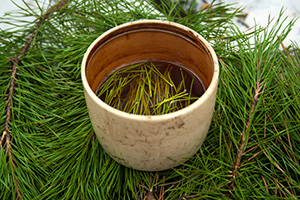
Pine needles are an excellent source of vitamin C, though I wouldn’t just eat a handful of needles. You can add small amounts to recipes for a spicy, piney kick. They also can be brewed into tea. Each pine is going to have a distinct flavor and some are more commonly used than others.
Both pine pollen and pine bark can be used as a flour substitute.
Final Thoughts
There are many more edible trees out there that I didn’t include in this list. For example, the nuts from trees in the Juglandaceae family, like pecans and hickories, are all edible. And there are many fruit trees like PawPaw, Cherry, and Mulberry trees that are edible as well.
Once you open your eyes and look around, you will find that the forest is full of edible trees.
But remember, when foraging, also make sure you consult an expert or use a guide. There are many poisonous look-alikes out there.

MORE ARTICLES :
The post The Most Common Edible Trees Growing In Your State appeared first on Bio Prepper.
By: Rachael Blasbalg
Title: The Most Common Edible Trees Growing In Your State
Sourced From: www.bioprepper.com/2021/09/25/the-most-common-edible-trees-growing-in-your-state/
Published Date: Sat, 25 Sep 2021 15:03:12 +0000
------------------------
 What is BushcraftSurvival SkillsToolsVideosBushcraft CampsBushcraft KitsBushcraft ProjectsPrivacy PolicyTerms And Conditions
What is BushcraftSurvival SkillsToolsVideosBushcraft CampsBushcraft KitsBushcraft ProjectsPrivacy PolicyTerms And Conditions
